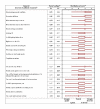Antibiotics for coughing in general practice: a questionnaire study to quantify and condense the reasons for prescribing
- PMID: 12217080
- PMCID: PMC126270
- DOI: 10.1186/1471-2296-3-16
Antibiotics for coughing in general practice: a questionnaire study to quantify and condense the reasons for prescribing
Abstract
Background: Antibiotics are being overprescribed in ambulant care, especially for respiratory tract infections (RTIs). Gaining insight into the actual reasons for prescribing remains important for the design of effective strategies to optimise antibiotic prescribing. We aimed to determine items of importance for the antibiotic prescribing decision and to make them operational for an intervention trial.
Methods: A postal questionnaire based upon focus group findings was sent to 316 Flemish general practitioners (GPs). On a verbal rating scale the GPs scored to what extent they consider the questionnaire items in decision making in case of suspected RTI in a coughing patient and how strongly the items support or counter antibiotic treatment. Factor analysis was used to condense the data. The relative importance of the yielded operational factors was assessed using Wilcoxon Matched Pairs test.
Results: 59.5% completed the study. Response group characteristics (mean age: 42.8 years; 65.9% men) approximated that of all Flemish GPs. Participants considered all the items included in the questionnaire: always the operational factor 'lung auscultation', often 'whether or not there is something unusual happening' - both medical reasons - and to a lesser extent 'non-medical reasons' (P < 0.001). Non-medical as well as medical reasons support antibiotic treatment, but non-medical reasons to a lesser extent (P < 0.001).
Conclusion: This study quantified, condensed and confirmed the findings of previous focus group research. Practice guidelines and interventions to optimise antibiotic prescribing have to take non-medical reasons into account.
Figures





References
-
- Kuyvenhoven M, de Melker R, van der Velden K. Prescription of antibiotics and prescribers' characteristics. A study into prescription of antibiotics in upper respiratory tract infections in general practice. Fam Pract. 1993;10:366–370. - PubMed
Publication types
MeSH terms
Substances
LinkOut - more resources
Full Text Sources
Medical

